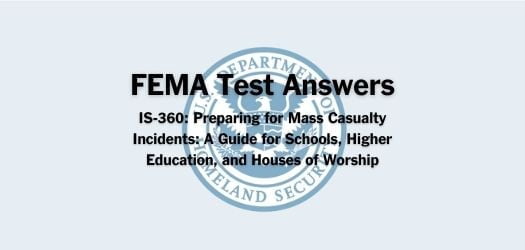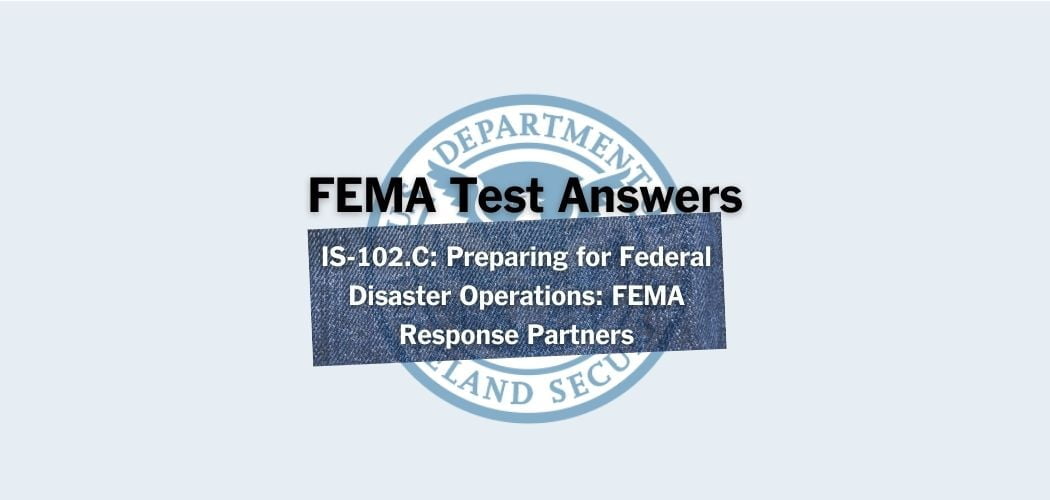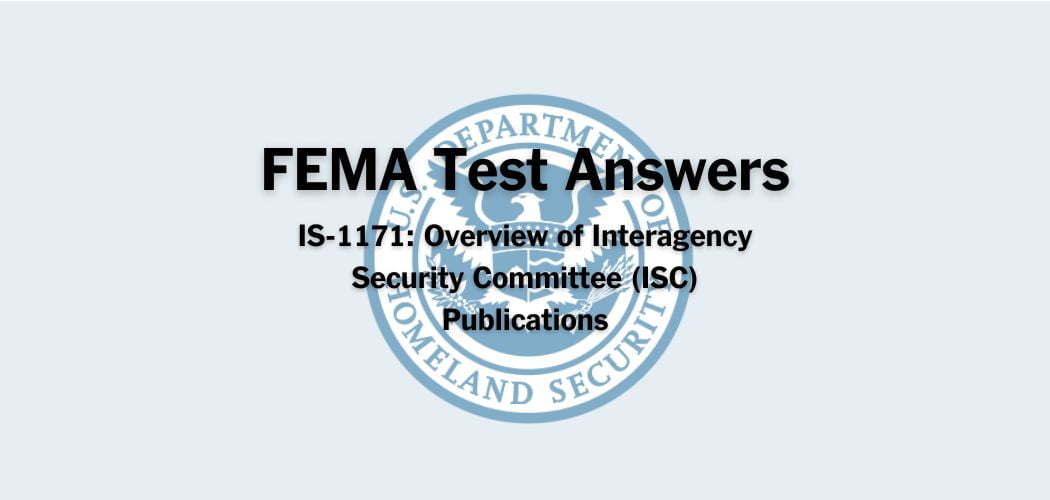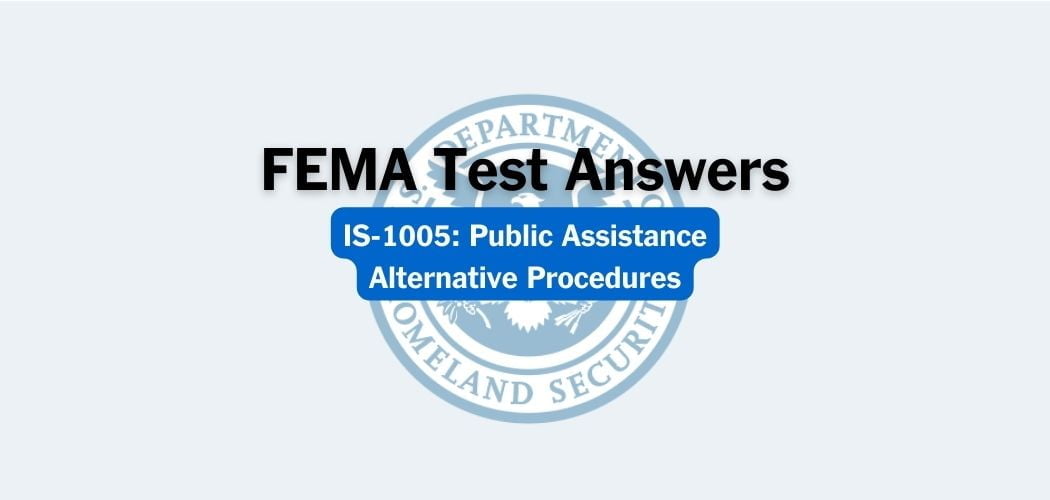Overview: The FEMA IS-922.A course was published on 7/6/2021 and was designed to explore how GIS technology can support the emergency management community. Topics addressed in this course include: GIS fundamentals and history; how GIS is used in emergency management and tools available to enhance GIS usefulness
Primary audience: The IS-922.A course is intended for Federal, state, local, and tribal emergency managers; state, local, and tribal GIS specialists responsible for risk assessment activities; regional personnel responsible for mitigation and response activities; other Federal agencies with a need to conduct risk assessment; and state, local, and tribal planners.
FEMA IS-922.A test answers
Each time this test is loaded, you will receive a unique set of questions and answers. The test questions are scrambled to protect the integrity of the exam.
Question 1. The Federal Disaster Mitigation Act of 2000 (DMA2K) mandated local governments to develop and adopt which document?
A. Multi-Hazard Mitigation Plan (MHMP)✅
B. FEMA’s Mapping and Analysis Center (MAC)
C. GIS Special Services Plan (GSSP)
D. FEMA Plan of 2001
Question 2. To be successful, GIS applications need to:
A. Leverage GIS base map layers maintained only by local government
B. Only use data appropriate for the query
C. Be general and use broad queries to gather the most information
D. Be specific and use data appropriate for the query✅
Question 3. Which of the following is NOT a GIS characteristic?
A. Accessibility✅
B. Temporality
C. Map Projection
D. Accuracy
Question 4. Which of the following is NOT a layer of a GIS Map?
A. Roads
B. Buildings
C. Regulations✅
D. Area
Question 5. Which GIS tool helps personnel at all government levels as well as those in the private sector and nongovernmental organizations?
A. GIS models that produce floor plans of damaged buildings
B. GIS models that produce maps✅
C. GIS models that require emergency response actions
D. Maps that ensure the ability to provide customers with critical information
Question 6. What type of epidemic in the 1850’s London did Dr. John Snow use an early form of GIS to track the spread of the disease?
A. Chickenpox
B. Cholera✅
C. Influenza
D. Bubonic Plague
Question 7. Locations of key infrastructures, such as fire halls, precinct houses, hospitals and shelters are types of:
A. Location Data
B. Point data✅
C. Aggregate data
D. Line data
Question 8. Which of the following is one activity that can be done to introduce first responders to GIS?
A. Learn on the job✅
B. Only rely on local GIS software
C. Disable the geospatial creation
D. Maintain existing maps
Question 9. Which of the following uses GIS to disseminate geographic information to Emergency Support Function (ESF) 5, Information and Planning, during disaster operations
A. GIS Satellite Operations
B. FEMA’s Mapping and Analysis Center (MAC)✅
C. GIS Special Services Plan (GSSP)
D. FEMA Plan of 2000
Question 10. Modern-day GIS is:
A. The software that generates information to describe structures and population
B. Used to generate a limited array of data in a variety of applications
C. A tool made up of links to websites that describe mapping features
D. The hardware, software, and methods that allow people to capture, store, manipulate, analyze, manage, and present geographically referenced data✅
Question 11. Which of the following is NOT a GIS use for preparedness?
A. Creating diagrams that do NOT improve communication during an incident or emergency✅
B. Developing secure, redundant GIS layers of local city/county critical infrastructure data, including a set of essential data with integrated data viewing and printing applications
C. Developing and maintaining lists of GIS emergency support personnel with location information, contact information, and specialized skills
D. Developing lists of detailed GIS data and resource requirements to support emergency management needs
Question 12. Which of the following is NOT a GIS data set?
A. Hazard impacts
B. Land ownership
C. Utilities
D. Local government officials✅
Question 13. One of the major initiatives of the Federal Geographic Data Committee (FGDC) is:
A. Federal Data Infrastructure Conclave (FDIC)
B. National Spatial Data Infrastructure (NSDI)✅
C. National Database on Infrastructure (NDO)
D. American Global Information Systems Infrastructure (AGISI)
Question 14. Which of the following is NOT a function of GIS components?
A. Create Raw Satellite Imagery✅
B. Store data
C. Create and/or input data
D. Modify data
Question 15. Which document requires the best available data to be used in a risk assessment?
A. Emergency Operations Plan (EOP)
B. DMA2K✅
C. GIS Special Services Plan (GSSP)
D. FEMA Plan of 2001
Question 16. Points, lines, and polygons that represent the locations and/or boundaries of map features are types of:
A. Point data
B. Map projection
C. Vector data✅
D. Raster modeling
Question 17. An example of a spread projection model software program developed by the Center for Disease Control (CDC) is:
A. CDC Flu 3 0
B. Community Flu 2 0✅
C. COVID Flu 1 0
D. Proximity Flu 2 0
Question 18. How is GIS NOT used to support emergency management?
A. To update the EOP
B. To support the EOP
C. To print the EOP✅
D. To modify the EOP
Question 19. Hazus represents which federal agency’s powerful risk assessment software program as of current?
A. National Aeronautics and Space Administration
B. Department of Energy
C. Department of Defense Office of Risk Assessment
D. Federal Emergency Management Agency✅
Question 20. Which entity is an organized structure of Federal geospatial professionals and constituents?
A. FGDC✅
B. IPAWS
C. NSDI
D. KTMZ
Question 21. Which of the following is NOT a GIS application?
A. Display documentation that display data but does not assign coordination✅
B. Developing secure GIS layers of local city/county critical infrastructure data, including a web application for data viewing and printing
C. Identifying the potential impacts due to an earthquake and assigning inspectors to specific neighborhoods
D. Modeling the positive benefits of mitigation to a hurricane-prone community
Question 22. What type of query is repeated frequently, but with different parameters within various geographic areas?
A. Dynamic✅
B. Aggregate
C. Simple
D. Complex
Question 23. GIS uses two main data types:
A. Polygon and Vector data
B. Vector and Raster data✅
C. Input and Raster data
D. Polygon and Raster Data
Question 24. This product is helpful for emergency managers because it illustrates areas that are now in the floodplain that previously were not It also helps residents to determine whether or not they are eligible to receive discounted flood insurance
A. Changes Since Last FIRM
B. Changes Since Last Formally Finalized✅
C. Changes Since Last Functionality
D. Changes Since Last Network Update
Question 25. What is the GIS software package that uses census data and other existing databases to estimate damage and losses from earthquakes, tsunami, hurricane winds, and floods
A. Integrated Public Alert and Warning System (IPAWS)
B. Geo-Targeted Alerting System (GTAS)
C. Hazards U S Multi-Hazard (Hazus)✅
D. Areal Locations of Hazardous Atmospheres (ALOHA)
Question 26. What is the main purpose of layers in GIS?
A. Enables manipulation until the desired base map is created✅
B. Enables a project management workflow with achievable objectives and goals
C. Enables all levels of Government to access GIS internal information and share it with each other
D. Enables infrared imagery prints to be made
Question 27. Which tool includes data for every census block in the United States
A. Shake Maps
B. GISPRO
C. Hazus✅
D. Geo-Targeted Alerting System (GTAS)
Question 28. Identify which of the following is typically used to display census blocks:
A. Location
B. Line
C. Polygon✅
D. Point
Question 29. Which of the following five steps of the Hazus Steps represents the 5th Step in the process?
A. Identify Hazards
B. Produce Maps, Tables, and Reports✅
C. Analyze Social and Economic Impacts
D. Consider What is at Risk
Question 30. Polygon data can be used to display:
A. Location Data
B. Line data
C. Aggregate data✅
D. Point data
Question 31. After GIS data sets, for example, have been organized, what type of relationships can be reviewed among the data on a map?
A. New Relationships
B. Spatial Relationships✅
C. Historical Relationships
D. Cross-Referenced Relationships
Question 32. Community assets such as locations of road salt or earth-moving equipment are types of:
A. Location Data
B. Line data
C. Aggregate data
D. Point data✅
Question 33. There is a variety of Federal, State, and local resources to support GIS needs Select the one that does NOT apply:
A. National Hurricane Center
B. Special Projects
C. Hazus
D. KTMZ✅
Question 34. What are the two main types of ways to analyze GIS data formally?
A. Objective and Subjective GIS Analysis
B. Tactical and Practical GIS Analysis
C. Simple and Complex GIS Analysis✅
D. Simple and Repeatable GIS Analysis
Question 35. Which century was GIS conceptualized?
A. 18th
B. 19th
C. 21st
D. 20th✅
Question 36. Which is NOT considered a main component of GIS?
A. Any nation’s orbital satellite data and imagery with freedom of sharing guaranteed by the United Nations✅
B. Analysis methods and tools
C. Base map
D. Input data



